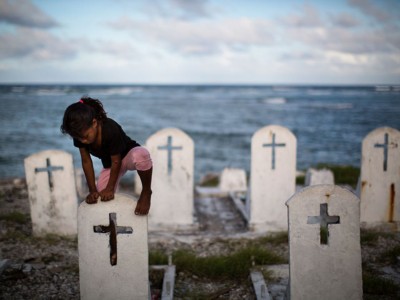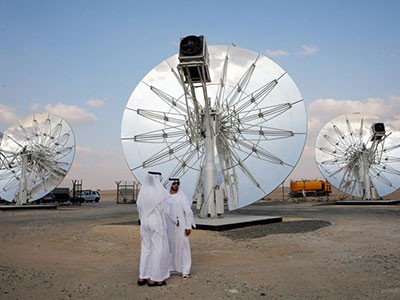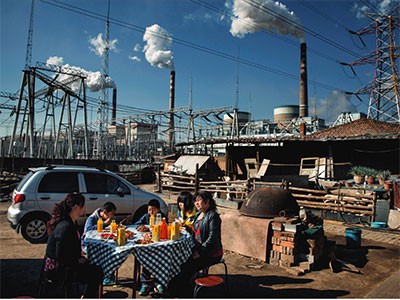If Current Trends Continue Climate Models Indicates That by 2100
As world leaders gathered to mark the start of 2050, they looked back on the coronavirus pandemic 30 years before as a turning point in the quest to rein in global warming. Nations pulled together to defeat the pandemic, and that launched a new era of cooperation to prevent a climate disaster. Investments in green energy and new technology yielded rapid cuts in emissions of carbon dioxide, putting the world on track to limit global warming to around 1.5 °C above pre-industrial levels.
Or maybe not. In 2050, the world could look back and see the pandemic as little more than a blip in a long and mostly futile effort to stave off global warming. Despite a temporary drop in carbon emissions from the 2020 outbreak, countries turned to cheap fossil fuels to revive their economies after the crisis. Carbon emissions soared and temperatures followed, setting the stage for 5 °C of warming by the end of the century.
These are just two possible visions of the future. Nobody knows how the current pandemic will play out; nor is it clear whether humanity will ultimately come together to avoid a potential climate catastrophe. But climate researchers need to explore what kinds of problem might emerge with different levels of warming. So they have developed a suite of scenarios intended to represent a range of futures that humanity could face1. Their goal is to investigate how different policies might alter carbon emissions — and how the planet will react to all of that heat-trapping gas.
At one end of the spectrum, optimistic scenarios explore worlds in which governments join forces to advance low-carbon technologies while reducing poverty and inequality. The other end sees countries ramp up their use of cheap fossil fuels, pursuing economic growth at all costs.
Research teams have been running these scenarios (see 'A range of futures') through the world's major climate models for the first time, providing projections of how Earth might respond to different socio-economic pathways. These simulations will inform climate research for years to come, and will play a central part in the next major assessment of global warming by the Intergovernmental Panel on Climate Change (IPCC), which is due out next year. The research could also have a key role in the negotiations around a new set of commitments to reduce emissions under the 2015 Paris climate agreement.

Source: Adapted from Fig. 3, B. C. O'Neill et al. Geosci. Model Dev. 9, 3461–3482 (2016)
These scenarios update a set that has been in use for the past decade, including one extreme — and controversial — version that projects a temperature increase of around 5 °C above pre-industrial levels by 2100. Critics have charged that this particular scenario, which has had a central role in climate studies for more than a decade, is misleading because it includes unrealistic amounts of coal use — a roughly fivefold increase by 2100. But many researchers dismiss that criticism, saying that even such high-emissions scenarios have value as long as people understand their underlying assumptions and limitations. A massive release of methane from Arctic permafrost, for example, could have a similar effect to huge surges in fossil-fuel use.
"We're trying to understand risks, not predict the future," says Donald Wuebbles, an atmospheric scientist at the University of Illinois at Urbana–Champaign and a coordinating lead author on the first volume of the latest US national climate assessment2, released in 2017. The scenarios are not designed to project emissions, but to investigate different levels of warming and types of economic development. They help a wide variety of researchers: climate modellers use them to test their models and project the impact of increasing greenhouse-gas emissions; economists need them to explore the costs of policies; and ecologists rely on them to predict changes to ecosystems around the globe.
"This is not science fiction," says Kristie Ebi, an environmental-health researcher at the University of Washington in Seattle who co-chairs the committee that developed the new scenarios. "We need these model results to give us insights into the impacts of our choices, and now we can do that."
Unusual business
In April 1989, a group of experts tasked with forecasting potential futures met in Bilthoven, the Netherlands, to prepare for the first IPCC assessment, which was due out the following year. They created scenarios describing how much carbon dioxide, methane and other heat-trapping gases nations might produce over the next century3. And those possible future worlds — from the extremely polluted to the exceptionally clean — provided the raw material for climate modellers to project how the planet might react.
Since then, the IPCC has updated the main emissions scenarios several times. But the situation changed in 2006, when the IPCC decided to get out of the scenario-development business because of pressure from the United States and others who argued that the organization should assess, not guide, science.

Where climate cash is flowing and why it's not enough
So, in 2010, a self-appointed group led by climate scientist Richard Moss, then at the Joint Global Change Research Institute in College Park, Maryland, published a new framework for creating and using scenarios designed to guide research for the IPCC's last assessment4, which was released in 2013–14.
The group provided a set of four projections of future carbon pollution levels — dubbed Representative Concentration Pathways (RCPs) — that could be run by climate-modelling groups around the world to produce forecasts about the fate of the planet5. The RCPs were selected to portray different levels of radiative forcing — a number that reflects how much extra warming results from greenhouse-gas emissions. The RCPs weren't intended to describe particular emissions trends or project how economies and technology might change. That job was left for other researchers, who would later produce sets of emissions trends that could drive greenhouse-gas concentrations in ways that mimic the RCPs.
Moss says the RCPs were designed to capture the spectrum of warming possibilities in the scientific literature and create a significant enough range between the high and low projections that climate modellers would be able to differentiate between them. And one major appeal of the scenario with a 5 °C global temperature increase that elicited so much criticism — called RCP8.5 — is that it provides modellers with a powerful signal. "We wanted to give enough detail so that climate modellers could do their work," says Moss. Regarding the individual scenarios, he adds, "we never meant to give them any particular weight".
Over time, however, the RCPs took on a life of their own. Although the caveats and qualifications are all there for those who know where to look, many scientists and others started using RCP8.5 to represent a world without aggressive climate action.
"It's very tempting to use RCP8.5 for a whole range of reasons, but it's also pretty unrealistic," says Glen Peters, a climate-policy researcher at the Center for International Climate Research in Oslo and co-author of a recent commentary on the issue6. "The question is how you balance those issues and communicate what it represents."

Model and manage the changing geopolitics of energy
The mischaracterization of RCP8.5 — as a projection of what could happen in a business-as-usual world in which governments fail to enact climate policies — is endemic, says Roger Pielke Jr, a science-policy researcher at the University of Colorado Boulder. Pielke says that even major scientific reviews such as the US national climate assessment have defaulted to using RCP8.5 as a de facto baseline scenario in which emissions continue to spike. That inflates projections of the effects of global warming — as well as of the costs of inaction, he says.
Wuebbles defends the decision to use RCP8.5 in the US assessment2. The document refers to RCP8.5 merely as a "higher" scenario. It notes that emissions were consistent with this scenario for 15–20 years, until they levelled off for a few years around 2014.
Moreover, RCP8.5 provides scientists with a high-risk scenario that is valuable for understanding the risks posed by climate extremes, says Céline Guivarch, a climate-change economist at the Centre for International Research on the Environment and Development (CIRED) in Nogent-sur-Marne, France. Many scientists argue that even if coal use doesn't rise in a catastrophic way, 5 °C of warming could occur by other means, including thawing permafrost.
After the RCPs were published in 2010, the plan was to have a new set of fleshed-out socio-economic scenarios ready within two years. Those would have fed into the IPCC reports that came out in 2013 and 2014, which found that the rate of warming since 1950 is unprecedented over a timescale of centuries to millennia, and set the stage for the 2015 Paris climate accord.
But the process was much more difficult — and took a lot longer — than anticipated. The new generation of scenarios, known as Shared Socioeconomic Pathways (SSPs), were not introduced until 2015. Only now, as the major climate-modelling centres around the world run their experiments for the 2021 IPCC assessment, are they taking centre stage in climate research.

The hard truths of climate change — by the numbers
Although based on the old RCPs, the new scenarios for the first time present fully fleshed-out narratives about how the world might evolve. Each provides a broad storyline about how the world might change, as well as numbers for key demographic trends — population, economic productivity, urbanization and education — in every country on Earth, which modellers then use to simulate emissions and planetary impacts.
The teams that produced the SSPs intentionally left out any climate policies. This approach allows scientists to run their own experiments and test the impacts of different decisions by governments and societies, says Ebi. The flexibility allows her and other public-health researchers to compare and contrast the health benefits from climate policies that simultaneously reduce carbon emissions and result in cleaner air.
"You couldn't do that before," Ebi says. "It's allowing the climate community to ask questions that we couldn't ask."
Rocky road
Although the SSP scenarios are only a few years old, they were developed in a world very different from today's. They were shaped before the political upheaval of 2016, when the United Kingdom voted to exit the European Union and the United States elected President Donald Trump, who promised to put America first and withdraw from the Paris climate treaty.
But the teams that drafted the SSPs imagined a storyline that is very close to the path that the United States and other major powers are taking. The SSP3 scenario, called "regional rivalry — a rocky road", is defined by a resurgence of nationalism. It sees concerns about economic competitiveness and security lead to trade wars. As the decades progress, national efforts to lock down energy and food supplies short-circuit global development. Investments in education and technology decline. Curbing greenhouse gases would be difficult in such a world, and adapting to climate change wouldn't be any easier. Under this scenario, the average global temperature is projected to soar to more than 4 °C above pre-industrial levels.
For Ebi, it's a lesson in humility, because the scenario seemed outlandish when it was developed. But that is the point.
"When we started working on this, there was no discussion of America first, there was no Brexit, there weren't trade wars between the United States and China," she says. "It's uncomfortable, but you need to have those kinds of pathway. We don't know what the future is going to look like."
Source: https://www.nature.com/articles/d41586-020-01125-x
0 Response to "If Current Trends Continue Climate Models Indicates That by 2100"
Post a Comment